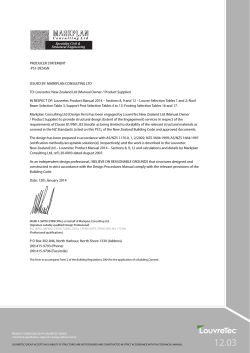
1 of 37 © Boardworks Ltd 2006
1 of 37 © Boardworks Ltd 2006 2 of 37 © Boardworks Ltd 2006 Human impact on the environment How does human activity affect the environment? 3 of 37 © Boardworks Ltd 2006 Population growth There are about 6.6 billion people in the world and over 95 million babies are born per year – that is an average of three babies per second! Has the rate of population growth always been the same? 4 of 37 © Boardworks Ltd 2006 Exponential growth 5 of 37 © Boardworks Ltd 2006 Exponential growth The human population is said to be growing exponentially. This means that the larger the population, the faster it grows. An increase in average life expectancy is largely responsible for the rapid increase in population. Why do people live longer than they did hundreds of years ago? better healthcare (hospitals, medicines, vaccines) more and better food cleaner water better sanitation The biggest increase in population is in developing nations, rather than developed nations. Why do you think is the case? 6 of 37 © Boardworks Ltd 2006 Predicting future growth rate Computer models can be used to make predictions about population growth by using assumptions about birth rate. Most analysts assume that birth rates will fall within the next 50 years. Why do you think this might happen? decreased fertility lack of resources disease war How important do you think predictions about climate change and unsustainable development are in the analysts’ calculations? 7 of 37 © Boardworks Ltd 2006 Future population growth 8 of 37 © Boardworks Ltd 2006 9 of 37 © Boardworks Ltd 2006 Air pollution Human activity produces two main types of air pollutant: noxious gases – These include carbon dioxide (CO2), sulfur dioxide (SO2) and nitrogen oxides (NOx). particulates – These are tiny particles suspended in air (e.g. smoke) and which are usually produced by the combustion of fossil fuels. Air pollution has been a major problem since the Industrial Revolution of the late 18th Century, and has been made worse by humans’ reliance on burning fossil fuels for energy. Air pollution, global warming, acid rain, damage to the ozone layer and smog. Each of these has serious implications for the environment and human health. 10 of 37 © Boardworks Ltd 2006 Global warming and greenhouse gases One of the greatest threats caused by air pollution is global warming. Global warming is caused by a build-up of greenhouses gases, which leads to an increase in the Earth’s temperature. A greenhouse gas is an atmospheric gas that absorbs infrared light. Key greenhouses gases include: carbon dioxide (CO2) methane (CH4) water vapour (H2O) nitrous oxide (N2O) 11 of 37 © Boardworks Ltd 2006 The greenhouse effect 12 of 37 © Boardworks Ltd 2006 The greenhouse effect 13 of 37 © Boardworks Ltd 2006 How hot can the greenhouse effect get? The planet Venus is further from the Sun than Mercury but has an higher average temperature. Its surface can reach up to 482°C, which is hot enough to melt lead! Venus’ atmosphere is mostly made up of carbon dioxide, which traps so much of the solar radiation that the planet becomes extremely hot. The hostile climate conditions on Venus make it impossible for life to survive. 14 of 37 © Boardworks Ltd 2006 Greenhouse gases 15 of 37 © Boardworks Ltd 2006 What is global warming? The term “global warming” is often used in connection with climate change, but what does it mean? Global warming refers to the increase in the Earth’s temperature due to the greenhouse effect, which can cause changes in climate. However, the term “global warming” is being used now to refer to the warming predicted to occur as a result of increased emissions of greenhouse gases and other human activities. This enhanced greenhouse effect may lead to significant climate change. Remember, global warming and climate change are not the same thing and should not be used interchangeably. 16 of 37 © Boardworks Ltd 2006 Why is carbon dioxide so important? Carbon dioxide is considered the most significant greenhouse gas. This is because carbon dioxide can remain in the environment over a long time, from 50 to 200 years. Any process producing carbon dioxide today could affect the climate for hundreds of years. Carbon is present in all living things and moves through the environment in a chain of reactions called the carbon cycle. Levels of carbon dioxide in the atmosphere have increased since the industrial revolution in the 19th century. How might human activities have contributed to this? 17 of 37 © Boardworks Ltd 2006 Atmospheric carbon dioxide 18 of 37 © Boardworks Ltd 2006 Carbon dioxide levels Carbon dioxide is one of the most important greenhouse gases because atmospheric concentrations have risen dramatically over the past century. Why do you think this is? Burning fossil fuels, deforestation and flooding land for the construction of hydroelectric dams have all contributed to rising levels of carbon dioxide. How many examples of burning fossil fuels can you think of? Are there any alternatives? 19 of 37 © Boardworks Ltd 2006 What is the carbon sink? Before the industrial revolution, carbon dioxide levels were usually kept in check by the carbon sink – forests and oceans that capture and store carbon. forests – All green plants absorb carbon dioxide as part of photosynthesis. The absorbed carbon is only released back into the atmosphere when the plant dies and rots, or is burned. oceans – Carbon dioxide dissolves in sea water, depending on the temperature and pressure. Tiny marine animals called phytoplankton extract carbon from the carbon dioxide to make their skeletons and shells. 20 of 37 © Boardworks Ltd 2006 The carbon sink 21 of 37 © Boardworks Ltd 2006 Acid rain 22 of 37 © Boardworks Ltd 2006 What damages the ozone layer? The ozone layer is a protective part of the atmosphere that absorbs some of the Sun’s damaging ultraviolet (UV) rays. Damage to the ozone layer means that more UV rays reach Earth, increasing the risk of skin cancer. The ozone layer is damaged by chemicals called chlorofluorocarbons (CFCs), which contain the elements carbon, hydrogen, chlorine and fluorine. CFCs are used in fridges and freezers, aerosol sprays and packaging materials such as polystyrene. The production and use of CFCs is now banned in many countries and could be worldwide in a few years. 23 of 37 © Boardworks Ltd 2006 What is smog? Smog is a mixture of air pollutants and particulates that is sometimes found in the lower levels of the atmosphere. It has a distinctive brownish haze. Smog can reach dangerous levels in builtup areas, causing irritation to the eyes and lungs. A large part of smog is ground-level ozone, a highly toxic gas. Ozone is formed when nitrogen oxides and hydrocarbons react with oxygen, in a reaction catalyzed by sunlight. 24 of 37 © Boardworks Ltd 2006 25 of 37 © Boardworks Ltd 2006 Water pollution Sewage, industrial waste, oil, pesticides and fertilizers all pollute water. Fertilizers and sewage can easily be washed into rivers, streams and lakes. The nutrients, phosphates and nitrates in these substances cause eutrophication. Eutrophication is the accumulation of nutrients in water, which causes excessive algal growth. This leads to a reduction in oxygen levels and the death of aquatic life. 26 of 37 © Boardworks Ltd 2006 Eutrophication 27 of 37 © Boardworks Ltd 2006 Eutrophication 28 of 37 © Boardworks Ltd 2006 29 of 37 © Boardworks Ltd 2006 Land pollution Land and soil can be polluted by two main types of substance: solid waste – such as plastic, metal, paper and other manmade substances chemicals – such as herbicides and pesticides, crude oil and waste from industrial processes. Land pollution often leads to water pollution, as chemicals are washed into rivers and lakes. 30 of 37 © Boardworks Ltd 2006 How much waste? Every year, billions of tonnes of paper, plastics, synthetic materials, metal and wood are thrown away. On average, each UK household produces over 1 tonne of rubbish each year. How could you estimate the amount of rubbish you throw away each year? 31 of 37 © Boardworks Ltd 2006 What are the options? What methods are there for disposing of waste materials? Landfill is the cheapest solution, but sites quickly become full and the waste contaminates the surrounding air, soil and water. Incinerating waste reduces volume, but often produces toxic chemicals. Recycling materials allows them to be useful again, and reduces the need to use more raw materials. Composting uses natural biological processes to decompose organic materials, but cannot be used to dispose of non-biodegradable waste. 32 of 37 © Boardworks Ltd 2006 What is the best solution? The best way to deal with waste is to produce less of it! It takes 100 kg of resources to make 10 kg of shopping, and most of that ends up in the bin. If products were redesigned to be biodegradable or easier to recycle, the amount of waste and disposal costs would be significantly reduced. How could you reduce the amount of waste you produce? 33 of 37 © Boardworks Ltd 2006 Recycling rates 34 of 37 © Boardworks Ltd 2006 35 of 37 © Boardworks Ltd 2006 Glossary (1/2) biodiversity – The number of different species within a specific habitat. chlorofluorocarbon – A chemical that damages the ozone layer. eutrophication – Over-enrichment of water with nutrients, causing excessive algal growth and reduced oxygen levels. global warming – The rise in the Earth’s temperature caused by an increase in greenhouse gases from human activity. greenhouse gas – A gas that traps the Sun’s infrared radiation in the Earth’s atmosphere. 36 of 37 © Boardworks Ltd 2006 Glossary (2/2) indicator species – An organism whose presence or absence provides information on environmental conditions. ozone – A gas that is toxic at ground level but which forms a protective layer higher in the Earth’s atmosphere. particulate – A type of pollution consisting of tiny particles, such as smoke. pollutant – A substance that contaminates air, water or land. smog – A hazardous type of air pollution containing ozone and particulates. 37 of 37 © Boardworks Ltd 2006 Anagrams 38 of 37 © Boardworks Ltd 2006 Multiple-choice quiz 39 of 37 © Boardworks Ltd 2006
© Copyright 2025












